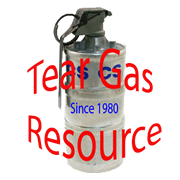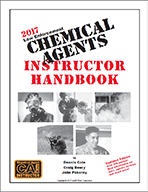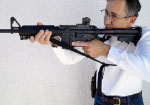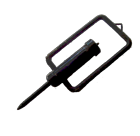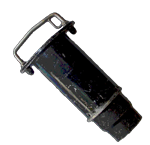Nonlethal chemical agents, properly deployed by trained law enforcement personnel, are designed to cause temporary discomfort. The application of nonlethal chemical agents, including oleoresin capsicum (OC), has proven effective in a wide variety of civil disobedience situations. Use of nonlethal chemical agents during civil disobedience may be reasonable depending on the totality of the circumstances. Each agency should consider when, where, and how nonlethal chemical agents may be deployed.1 No truer words have been spoken.
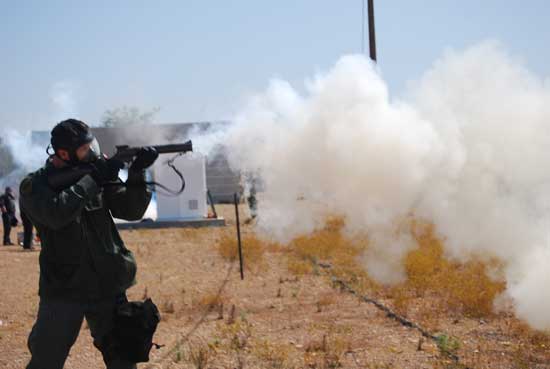
When deploying Chemical Agents outdoors, in most cases that will involve civil disobedience. Many things need to be considered prior to the decision to deploy. Some of these are:
- Law Violations by protesters
- Non-compliance, civil disobedience situations
- Peace officer safety
- Personnel available
- Methods of delivery available
- Weather conditions
- Wind direction
- Physical location/terrain considerations
- Cross contamination problems
- Mobility of protestors (suspects)
- Types of agents available
- Protective devices for involved personnel both police and suspects
- Decontamination
- The potential exposure to children, elderly, and disabled members of the crowd
After the decision to use chemical agents on a crowd and prior to deploying chemical agents outdoors, several things that are very important need to be calculated; wind direction and avenue of escape. Two elements that always need to be present, medical services and fire suppression capability. Many other factors such as alternatives, protestor sophistication, how to work in agent if your APR comes off, etc., also need attention
Wind direction is the first and most necessary piece of information to solve the big puzzle, “How to safely move the crowd”. All other planning depends on this evaluation. When you deploy agent where will the cloud go? Ideally the entire agent release will only move towards the protestors, however, many agencies do not plan far enough ahead and the cloud of agent blows back on the police lines or into neighborhoods or building where it will cause more harm than intended, I.E. hospitals, schools, retirement communities, etc.
Also, take into account wind speed. If the wind is blowing to hard, like a fresh breeze at 19-24 MPH it may be to fast for the chemical agent to be effective. If the wind raises dust and loose paper and small branches are moved it may indicate a fresh breeze. (See Beaufort wind scale) If at all possible keep your police lines upwind of your agent release. 
The second possibility is release of your agent to the side of a crowd and upwind so that it will mostly blow on the suspects.
 The worst scenario is to release your agent into the wind and have it envelop your police lines.
The worst scenario is to release your agent into the wind and have it envelop your police lines.
Mechanical wind turbulence and  humidity will also play a role in your planning. How will the wind go up, around and over obstructions such as building? Will the humidity help keep the agent close to the ground or will the agents rise quickly missing the crowd. A small test release of agent or smoke may help answer these questions.
humidity will also play a role in your planning. How will the wind go up, around and over obstructions such as building? Will the humidity help keep the agent close to the ground or will the agents rise quickly missing the crowd. A small test release of agent or smoke may help answer these questions.
Avenues of Escape is the second consideration in your planning. Where do you want the suspects to go when you disburse them and how are you going to get them there? This may depend upon the situation but generally you will want them to leave the area. How are they going to do that? You need to make sure they go toward their parked vehicles or public transportation. If you let them stay in the area they will probably regroup and you will need to start all over again. Do not send them into an area where they have no escape from the agent you just released. Do not send them into a dangerous area, I.E. over a cliff, onto a freeway, into the ocean, etc.
After deciding where you want the crowd to go in conjunction with your wind analysis you can determine placement of you release line(s) and police line(s). Some outdoor tactics might include marking suspects for eventual arrest, moving the crowd, splitting the crowd. You may not arrest in all cases so a determination of arrests versus non-arrests needs to me made.
Police officers along with suspects are injured during crowd control. You should always have some sort of medical aid plan to include on site medical first responders. Alerting surrounding hospitals would be prudent. Alert them to the chemical agents you will be using and what types of injuries they might expect. As part of your medical aid plan you should prepare for the decontamination of police officers and suspects. Both should be decontaminated as quickly as possible in a safe location.
When using pyrotechnic devices there is always the chance that you might start a fire. Having the fire department standing by in a safe location is another responsibility that should be put into action at every incident. Always leave a liaison with the fire department to help control their actions. Firemen are trained to react and sometimes they may react to a fire and endanger themselves or the officers on the scene.
Having videographers is a smart idea. They can be both undercover and overt. This lets the crowd know that you are keeping track of who they are. Hopefully that will keep their criminal behavior down. It will also protect you from unwarranted complaints and help tell your story of how the civil unrest unfolded and what prompted your actions.
During civil unrest in Europe the throwing of Molotov cocktails at policemen in crowd control situations is common place.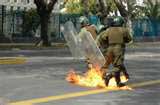 They all carry small fire extinguishers with them to put out fires on their partners clothing as necessary. How long before those same anarchists bring that tactic to us is unknown. Prepare for it now.
They all carry small fire extinguishers with them to put out fires on their partners clothing as necessary. How long before those same anarchists bring that tactic to us is unknown. Prepare for it now.
There are many different non-lethal chemical agents available to us in a crowd control situation. The most common practice is to use a pyrotechnic (burning) chemical agent. These are usually hand delivered to the release line. Most of these type devices can also be launched from a distance with absolutely no exact placement. When hand delivering pyrotechnic agents there is the possibility they can be picked up and thrown back at you. Have a contingency plan for that. Many agencies are using PepperBall Launchers to discourage anyone that is getting close to a burning canister from trying to pick it up or move towards the police.
Some agencies are trying liquid devices generally thought of as your hand held OC. However, there are other devices available that expend much more liquid agent and from distances up to 40 feet. These devices are generally thought of as safer to use, can’t be thrown back. Be sure you are up on the latest 9th circuit court appeals ruling on the use of liquid OC and use these devices appropriately.
To be successful using non-lethal chemical agents outdoors you must know what is available to you and how what you have works. How will your agents affect protestors and the police that may get exposed? Know your agencies capabilities and limitations. Know your agencies policies. (See Oakland PD policy) What are your alternatives if you decide you don’t want to use chemical agents?
I know there are many other alternatives. Be aware of what is available to use and balance the effectiveness and injury rate of each with non-lethal chemical agents. Use what is most appropriate for your situation. Much more can be learned by taking the CATO chemical agent’s instructors course.
